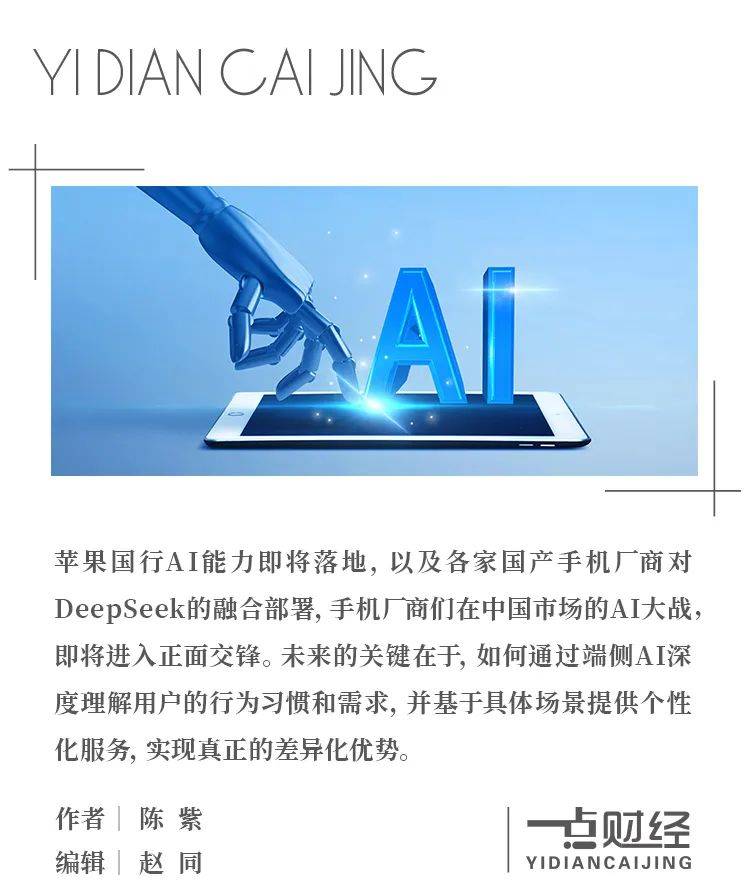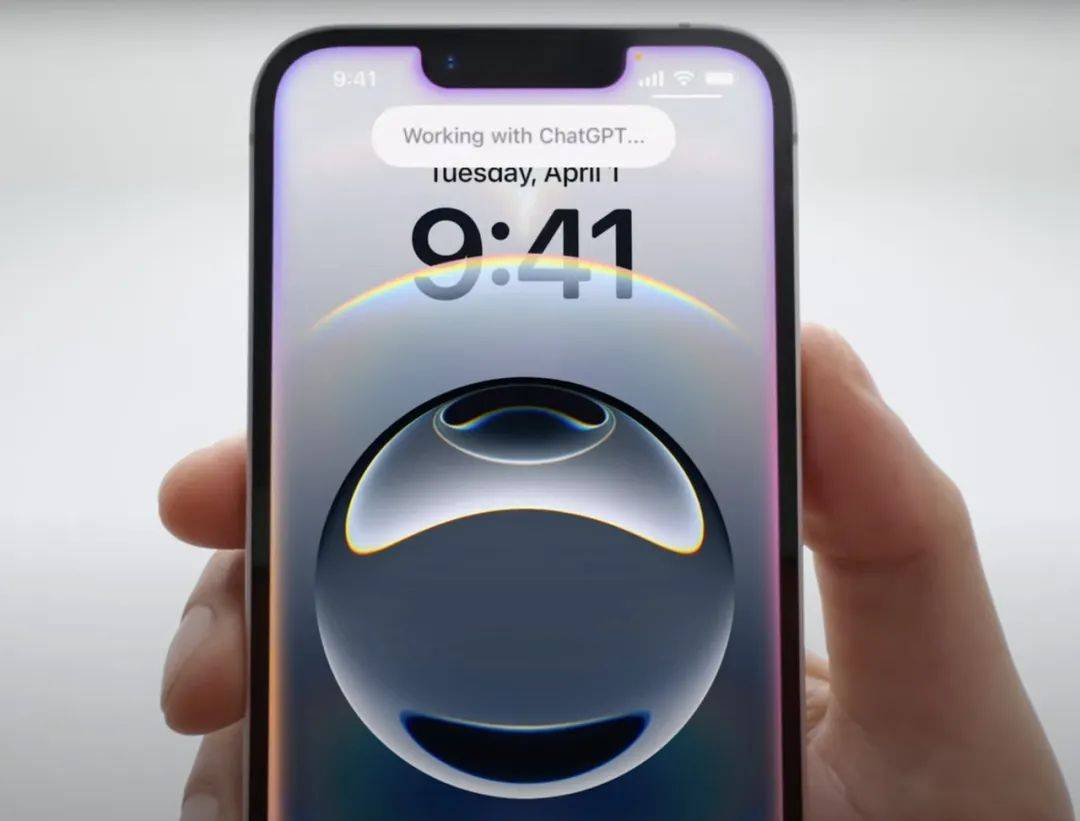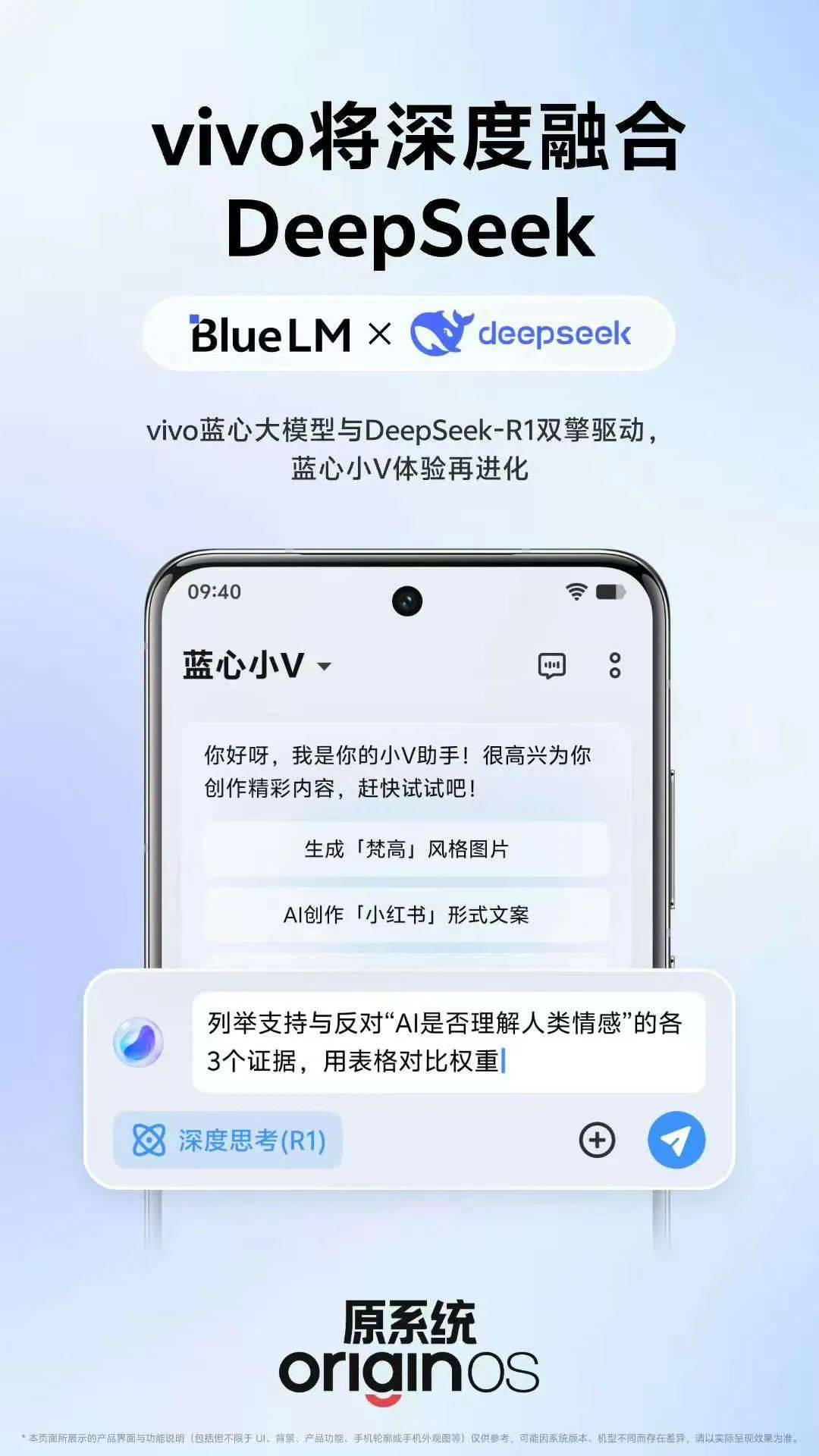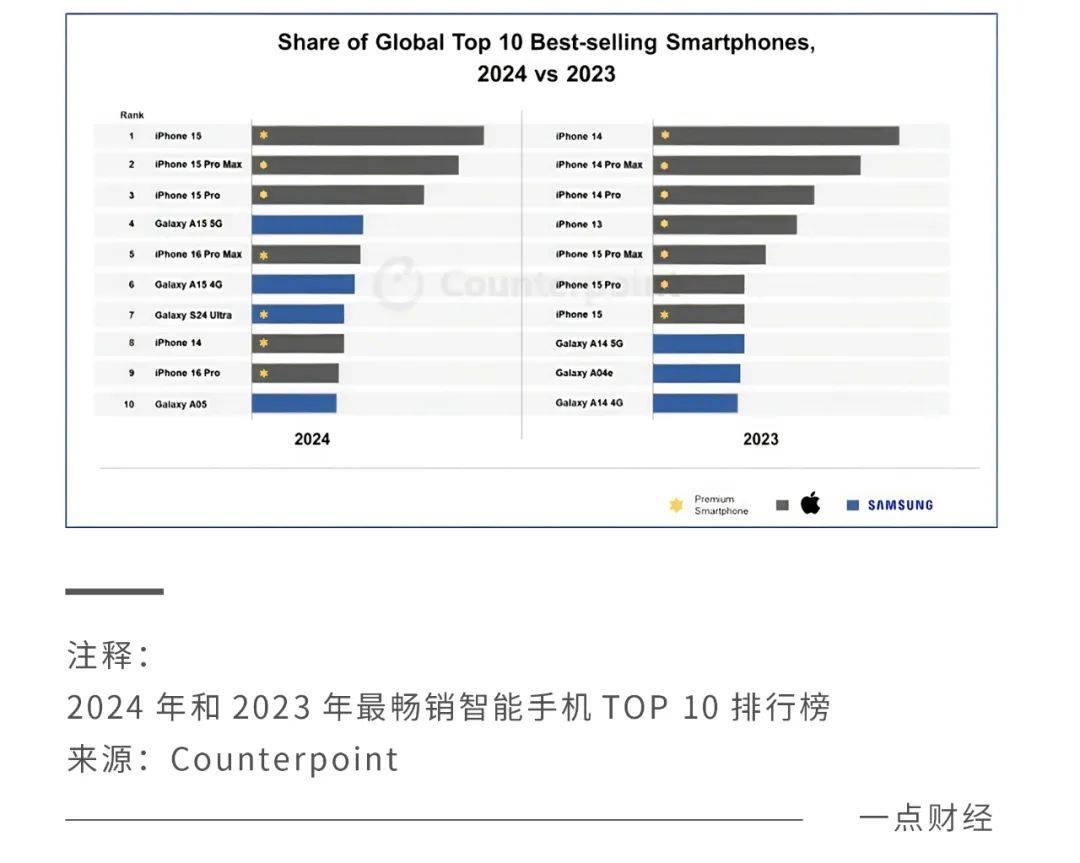AI Mobile Phones: Dawn of the "DeepSeek Era"?
![]() 02/25 2025
02/25 2025
![]() 544
544

2025 marks the inaugural year of AI commercialization, ushering in a fiercely competitive landscape within the smartphone industry.
Apple CEO Tim Cook noted that sales of the iPhone 16 series surpassed expectations in regions where Apple Intelligence technology was accessible. Conversely, the stagnant sales of iPhone 16 are attributed to the unavailability of AI technology in certain areas.
At the iPhone 16e launch event on February 20, Apple emphasized its commitment to releasing a multilingual version of Apple Intelligence, including Simplified Chinese, by April this year.

△iPhone 16e: The most affordable Apple AI smartphone
Following several speculations regarding Apple's AI functions in China, Alibaba emerged as the chosen partner. Subsequent rumors hinted at a potential collaboration with Baidu to develop AI search capabilities for image and text processing, thereby enhancing the Chinese version of Siri.
Prior to this, domestic mainstream mobile phone brands had already embarked on a "DeepSeek collective endeavor." Within a span of just three to four days, Huawei, Honor, vivo, OPPO, Xiaomi, and other manufacturers prominently integrated DeepSeek-R1 into their offerings.
Since the concept of AI mobile phones gained traction last year, virtually all mainstream mobile phone manufacturers have introduced their proprietary AI technologies, aiming to propel users towards phone upgrades.
With Apple's AI capabilities set to debut in China and domestic mobile phone manufacturers integrating DeepSeek, the AI battleground among Chinese market players is poised for a head-on confrontation.
AI Battleground
AI mobile phones have entered a new phase of direct competition.
To ensure the timely launch of Apple Intelligence in mainland China, Apple engaged in discussions with multiple domestic manufacturers, ultimately selecting Alibaba as its partner. Meanwhile, Baidu, initially rumored to be a partner, might focus on developing AI search functionalities for image and text processing. Samsung announced its collaboration with Zhipu's Agentic GLM to equip its new phone, Galaxy S25, with AI capabilities.
For Apple, selecting the right AI partner in China is crucial, as it directly impacts market share fluctuations. China stands as Apple's second-largest market after the United States. However, over the past two years, Apple's revenue in China has consistently declined, with a year-on-year drop of 11% in the first fiscal quarter of fiscal year 2025 (fourth quarter of 2024).
From a progress standpoint, the AI capabilities of these two global smartphone giants in China still require time for adaptation and development. In contrast, domestic mobile phone manufacturers have made strides in AI, gaining increased confidence fueled by DeepSeek's global popularity during the Spring Festival.
The advantage of the DeepSeek large model lies in its capability to achieve high-performance reasoning at a lower training cost. The open-source approach enables enterprises to customize according to their specific needs, addressing shortcomings in large model research and development capabilities.
On February 5, Huawei led the charge by launching the beta version of the DeepSeek-R1 agent on the Xiaoyi App within the pure HarmonyOS system, upgrading it to the official version a few days later with the addition of the "online search" function.
Subsequently, on February 8, Honor announced the official integration of DeepSeek. Users with system versions above MagicOS 8.0 can upgrade YOYO Assistant to the latest version, enabling seamless conversations with DeepSeek-R1.
vivo also officially announced the integration of its Blue Heart large model with DeepSeek, offering functionalities such as image generation, AI text creation, and AI question and answer.

On February 20, OPPO, during the launch of its folding flagship Find N5, announced that Xiao Bu Assistant would fully integrate DeepSeek, supporting deep thinking and online search, eliminating the need for users to download and open through multiple steps.
On February 23, Xiaomi's Super Xiaoai also launched DeepSeek-R1, defaulting to online search and activable by entering "open deep thinking".
Over the past year, major mobile phone manufacturers have accelerated their AI technology deployments. Huawei boasts the "Pangu large model," Xiaomi has "Super Xiaoai," vivo features the "Blue Heart large model," OPPO presents "AndesGPT," and Honor introduces the "Magic large model".
In this competition, manufacturers have discovered numerous functional innovations. For instance, AI photo editing removes unwanted elements, AI fills in gaps to reduce incongruity, AI translation and automatic subtitles facilitate video browsing, and AI semantic summarization enhances office efficiency.
With DeepSeek's support, the user experience will undoubtedly elevate, but users can also access most functions through the DeepSeek APP. Hence, mobile phone manufacturers' official announcements of integration do not necessarily confer uniqueness.
However, the trend is undeniable, and the DeepSeek train must be boarded. This underscores an industry dilemma: in the iterative configuration of smartphones, the mantra in the digital realm is, "I may not use it, but you can't not have it." Telephoto macro, ultrasonic fingerprints, and four-sided full-screen configurations have all undergone rigorous scrutiny by netizens, and the current buzzword, AI, is no exception. Any manufacturer missing out on AI functionality risks falling behind, making negligence unthinkable.
DeepSeek Moment?
The outlook for AI is undeniably promising. According to Canalys, in 2024, the penetration rate of AI mobile phones reached 17%, and it is anticipated that the penetration of AI mobile phones will further accelerate in 2025, driving the global penetration rate to 32%.
While data suggests AI is a growth driver in the smartphone market, a closer look reveals it's more accurate to describe AI as a lifeline that mobile phone manufacturers are fiercely clinging to amid "innovation exhaustion." Nowadays, any newly launched model highlights AI capabilities as a key selling point.
iPhone pioneered the smartphone era, and since then, the metaphor of an "iPhone moment" has been employed at critical development junctures across industries. Does this signify that the domestic smartphone industry has embraced a "DeepSeek moment"?
This necessitates an analysis of the functional enhancements brought by DeepSeek and its subsequent impact.
Previous large models primarily served to answer simple questions and assist users in obtaining filtered answers. This not only demanded precise prompts from users but also required users to break down complex, multifaceted questions into separate inquiries, then compile the answers. This process significantly compromised user experience in terms of efficiency and accuracy.
This time, DeepSeek introduces a revolutionary experience, prompting Zhu Xiaohu, who initially doubted AGI's success at this stage, to exclaim, "Has AI developed consciousness?" What prompted his 180-degree attitude shift is that DeepSeek appears to genuinely think.
When responding to user queries, DeepSeek presents a detailed thinking process, as if it comprehends the meaning, articulates contextual logic seamlessly, and even employs tone in word choice and sentence construction. It first acknowledges the question's value, then empathizes with the user's intent, and answers to meet their expectations.
This "thoughtful" experience represents a dimensional leap compared to previous clunky mobile phone intelligent assistants that addressed one question at a time. With DeepSeek's support, it's indeed feasible to upgrade AI experiences like smart question and answer.
However, its impact may be limited, as the ultimate test lies in user adoption.
During usage, users inevitably ponder the difference between downloading apps like DeepSeek, Wen Xiaoyan, Tongyi, Doubao, and the AI functionality inherent in mobile phones. AI answers aren't always accurate. How can the "hallucination problem" be resolved?
These questions are challenging to answer at present, and from a data perspective, AI hasn't significantly boosted smartphone sales.
Canalys research indicates that during the fourth quarter of 2024, when mobile phone manufacturers intensively released AI flagship phones, China's total smartphone shipments increased by 5% year-on-year. However, this growth was primarily due to factors like national inventory subsidies and end-of-year promotions. AI's role was inconspicuous. Furthermore, in the 2024 best-selling mobile phone rankings, the iPhone 15 series, devoid of AI functionality, ranked highly, providing indirect evidence.

Moreover, following the September 2024 launch of the iPhone 16 series, Apple didn't reap significant benefits. According to Apple's report for the first fiscal quarter of 2025 (October to December 2024), iPhone sales declined by nearly 1 million units year-on-year, with net sales of $69.14 billion, lower than the $69.7 billion recorded in the same period last year.
Even with DeepSeek's popularity, the current AI trajectory still lacks killer applications. Once users' curiosity wanes, the usage rate of AI functions on mobile phones might further decline.
Currently, while DeepSeek brings heat to AI mobile phones, it cannot defy odds to alter fate.
AI Empowering Mobile Phones: A Long Journey Ahead
AI mobile phones undoubtedly represent the future trajectory for smartphones. But how reliant will users become on AI?
At least for now, it's premature to deem AI a fully dependable "smart butler." There's still ample room for improvement in result accuracy.
For example, in AI photo editing, whether it's elimination or expansion, inexplicable processing results often occur. In instruction interaction, AI occasionally misunderstands.
Even with DeepSeek's arrival, it's not omnipotent. It excels in logical reasoning but hasn't made significant progress in distinguishing content authenticity. The so-called "serious nonsense" hallucination phenomenon persists. Thus, the stronger the logical reasoning ability, the more absurd the errors can be.
For instance, digital enthusiast Xiao Chen engages with DeepSeek multiple times daily. In his view, it has partially replaced his need for a search engine. However, beyond that, Xiao Chen hasn't noticed a more substantial improvement. While it offers a more precise question and answer experience, it's limited to that.
"I'm still awaiting OPPO's Xiao Bu Assistant to integrate DeepSeek to see what kind of experience enhancement it brings. AI is a major trend, and I look forward to it becoming a reason for me to buy a new phone soon." Xiao Chen is optimistic about the future of AI mobile phones.
Besides experiential issues, AI security also warrants attention.
Last October, former Honor CEO Zhao Ming issued a single command at the launch event, and the phone automatically placed an order for 2,000 cups of coffee. This system-level deep function garnered significant attention.
Regarding this system-level function where AI interacts with applications automatically by accessing mobile phone screen information, 360 founder Zhou Hongyi raised security concerns – the Meituan App was unaware an AI was simulating human finger operations. This is also a concern regarding AI technology's development.
For AI to further advance, efforts from not only AI manufacturers but also mobile phone manufacturers, who are closer to consumers, are crucial. To achieve system-level AI operations, mobile phone manufacturers need to cooperate deeply with App manufacturers, connect third-party data and permissions, gradually build a vast AI ecosystem, and provide comprehensive security guarantees.
The entire mobile phone industry still awaits the further maturation of global technology, such as breakthroughs in hardware computing power and software experience upgrades. By then, AI mobile phones will have advanced to the next stage, and the answer to how much increment AI can bring to smartphones will become clearer.
Whether DeepSeek can truly turn the tide remains to be seen. What's certain is that technological development will persist. At every stage of stagnation, new technological iterations invariably lead to a "sudden turn for the better." As a rigid demand in life and work, smartphones are bound to continuously break paradigms and achieve progress.
Conclusion
Technological progress is accompanied by shifts in user habits.
As an essential daily tool, mobile phones' operating logic is already familiar and relied upon by users. While the enrichment of AI functions will greatly simplify usage habits, adapting to new interactions remains a challenge.
Moreover, AI's intelligence will gradually converge. The future key lies in how to deeply understand users' behavioral habits and needs through edge AI, and provide personalized services based on specific scenarios to outpace competitors and achieve a genuine differentiated advantage.
This is not only a consideration for mobile phone manufacturers but also a challenge faced by the entire AI industry.







